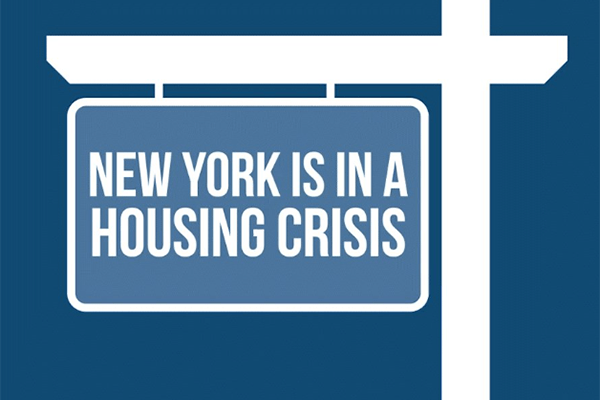|
RCBJ-Audible (Listen For Free)
|
Ramapo’s Housing Pace Continues While Remainder of Rockland County Shows Anemic Growth Based On Housing Permits
STATE NEWS
Gov. Kathy Hochul’s administration has made housing growth a top priority even though her efforts have been thwarted. To emphasize the point in raw data, the state has created a website that will track housing growth in every town, village, and city in New York.
In some jurisdictions, building is booming; in others, growth has remained static for five years. In nearly every municipality in Rockland County, housing growth is nearly imperceptible with the Town of Ramapo being the exception. The state database tracks the number of home-building permits approved in every town, village and city for the past five years based on annual counts from U.S. Census Bureau data.
A snapshot of Rockland indicates a near lack of growth across the county over the past five years in both towns and villages. In the Town of Clarkstown, the database shows 9 permits in 2022, 25 in 2021, 20 in 2020, 17 in 2019, and 16 in 2018. Those numbers are more robust – though still negligible – compared to the Town of Orangetown, which showed 11 permits in 2022, 8 and both 2021 and 2020, 11 in 2019 and 15 in 2018.
The Town of Clarkstown rezoned downtown Nanuet through its Transit Oriented Development (TOD) plan to attract new housing but there has been no activity to date. The town recently passed changes to its zoning code to stimulate additional housing along Main Street in New City.
The Town of Orangetown also floated the idea of creating a TOD around its train station to attract retail and denser housing but the plans have stalled.
Stony Point has had practically no home-building permits: 8 in 2022, 5 in 2021, 1 in 2020, 5 in 2019 and 4 in 2018. The town’s most obvious location for density housing is the fallow Letchworth site but voters last November rejected a proposal that included multi-family housing.
Similarly, according to the state database, the Town of Haverstraw shows no permits in all five years except one in 2021.
Unsurprisingly, Ramapo stands in stark contrast to Rockland County’s other four town with 290 permits in 2022, 338 permits in 2021, 310 permits in 2020, 219 in 2019 and 180 in 2018 – adding up to 1,337 permits largely driven by robust development within the Hasidic community.
An aggressive housing plan promoted by Gov. Kathy Hochul of New York aimed at creating 800,000 new homes across the state over the next decade disintegrated earlier this year in Albany after meeting with strong opposition from state legislators.
The plan would have forced New York’s cities, towns, and villages to allow more housing to be built, and mirrored what other states are already doing. It would have been a first for New York, where home prices and rents have skyrocketed to among the highest in the U.S. and where more than half of all residents spend at least 30 percent of their income on housing.
In 2022, the number of permits in Rockland County was 464 – but Ramapo represented more than half of the permits with 290. The Village of Nyack led the way with 28 permits, followed by Spring Valley with 24, and Chestnut Ridge with 20. Several villages reported zero growth; the majority had no more than five permits.
Hochul, a Democrat, had hoped to insert her housing plan into the state’s budget, which she is still discussing behind closed doors with fellow Democrats who control the State Legislature. Negotiations dragged on past the April 1 deadline. Mandates associated with the plan were heavily opposed by many lawmakers, both Democrats and Republicans, particularly in the State Assembly, even though lawmakers, town supervisors and mayors statewide are emphasizing the housing crisis in stump speeches and in public forums.
The dearth of home building has contributed to a statewide housing shortage. A December report from the nonprofit Regional Plan Association estimated that New York needs to add more than 817,000 homes in the next decade to keep up with population growth and ease overcrowding.
Hochul in her budget plans had proposed towns with train stations rezone them for denser housing but suburban lawmakers balked and were opposed to setting mandatory growth targets.
Hochul says she will revisit her mission in next year’s legislative session. But in the meantime, she is giving municipalities that meet housing targets a leg up in competing for state grants. Also, she has ordered a survey of state-owned properties to find suitable spots for new housing.
In both southern Westchester and Orange County, there are pockets of housing growth.
In downtown New Rochelle, the city has approved nearly 4,000 new homes in the past decade – the second highest of any town in the state outside New York City. Yonkers has approved 3,800 new homes in the last decade and White Plains green-lighted 2,600, according to the state-provided data.
In Orange County, housing growth also has been slow with the exception of the densely populated Hasidic village of Kiryas Joel, which approved nearly 3,500 permits over the past five years. The county’s towns and villages with some growth include Chester, Monroe, the Town of Newburgh, Walden and Warwick. Walden had a burst of 72 permits in 2022, a large uptick from previous years, and Wallkill has been steadily growing with 47 permits in 2022, 399 in 2021, 55 in 2020, 280 in 2019 and 74 in 2018.
Read also: Governor Hochul’s Housing Compact Was Right & The Public Knows It!
















